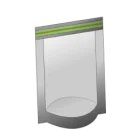How To Prolong Your Product’s Shelf Life
As a food business owner, you know that “shelf life” matters. The longer your food shelf life, the easier the shipping, storing and selling – there’s no doubt about that. So, we’d like you to learn some basic methods of increasing the shelf life of food. These methods are used alone or in combination to extend the normal biological life of foodstuffs and to grow your sales.
What Causes Short Shelf Life?
- Oxidation – Exposure to Oxygen
- Example: Biscuits
- When you leave the biscuit exposed in your kitchen within a few hours, the quality of the biscuit will be different. This is because it is exposed to oxygen.
- Moisture Build Up
- Example 1: Salted Egg Chips
- In 2019, salted egg chips became a trend, and you may have eaten one that lost its crunch. This is because there was a moisture build-up inside the pouch.
- Example 2: Vitamins
- Inside a bottle or pouch packaging of vitamins, you will find a pack of silica gel. It's placed to prevent moisture build-up inside the packaging that will damage the quality of the vitamins and without it, will shorten the shelf life of the vitamins.
- Exposure to Light
- Example: Coffee Beans
- Coffee beans exposed to light will become stale and lose its flavor. That’s why we always recommend using a pouch that has no window.
Packaging That Can Help Improve the Product’s Shelf Life
- Use Pouch materials with Aluminum layer (AL)
- UV light cannot penetrate into the pouch. If the item you will put inside the pouch is sensitive to UV light, it is best to use pouches with AL lining. Aluminum also gives the highest barrier so; we can expect a longer shelf life.
- Use Desiccants – There 2 types of Desiccants
- Oxygen Absorber – Oxygen Absorbers avoids oxidation (changing the color and quality of the product). This also avoids bacteria growth.
- Used For: Dry Foods (10% moisture or less) and low oil content
- Dried Mangoes (Prevents Browning)
- Cereals
- Dried Herbs, Beans, Etc.
- Cheese
- Flour and Grains (Chia Seeds, Quinoa, Etc.)
- Bread
- Peanuts
- Biscuits
WARNING: Please avoid using Oxygen Absorbers on Products with High Moisture Content.
- Silica Gel – Absorbs Moisture inside the pouch that causes molds (Amag). This also keeps your product brittle and crispy while inside the packaging.
- Used For:
- Chips
- Popcorn
- Medicines
- Dog Food
WARNING: Do not use if your product needs to retain its moisture or else the product's moisture will be lost and the product will deteriorate further (e.g., Hopia, Bread).
How Much Should I Use?
- Oxygen Absorber
- Pouch volume capacity 1mL = 0.26 cc of oxygen absorber. Provided below is a sample computation:
- Stand Up Pouch (12*20 cm) = 450 mL
- Computation: 450 x 0.26 = 117 cc
- Result: 1 pack of OXAB003 (160 cc) can be placed inside a stand-up pouch with a 12*20 centimeters size.
- Silica Gel
- Pouch volume capacity 1mL = 0.001 g of Silica Gel required. Provided below is a sample computation
- Zip Flat (20*30 cm) = 1800 mL
- Computation: 1800 x 0.001 g = 1.8g silica
- Result: 1 pack of SCGL009 is enough for 20*30 cm of flat pouch with zip lock
How Do I Keep/Store Unused Desiccants?
- Oxygen Absorber
- Vacuum Sealed (reseal)
- Silica Gel
- Tupperware
- Sealed Zip Bag
- Store in a Cool and Dry Place
Additional FAQs
- Why is my packet of Oxygen Absorber is starting to feel warm? - This means the oxygen absorber has been activated.
- How long is the shelf life of your Oxygen Absorber?
- Sealed Oxygen Absorber can last up to 6 months
- Opened and Exposed Oxygen Absorbers can only last up to 15 minutes
Link to our video:
https://drive.google.com/file/d/11PHl2KG52FwdfzHm--a-zqyXHyJtWVTn/view?usp=sharing









